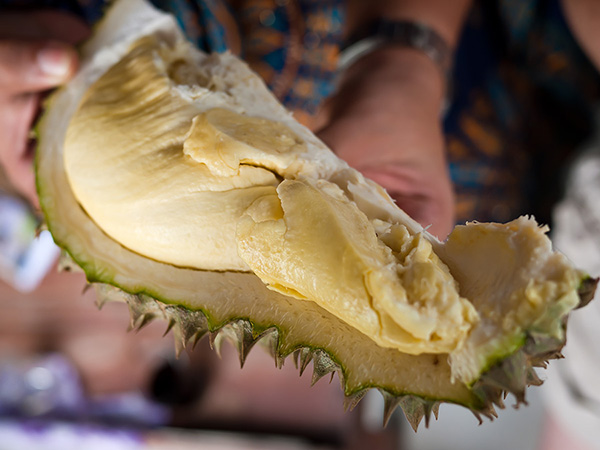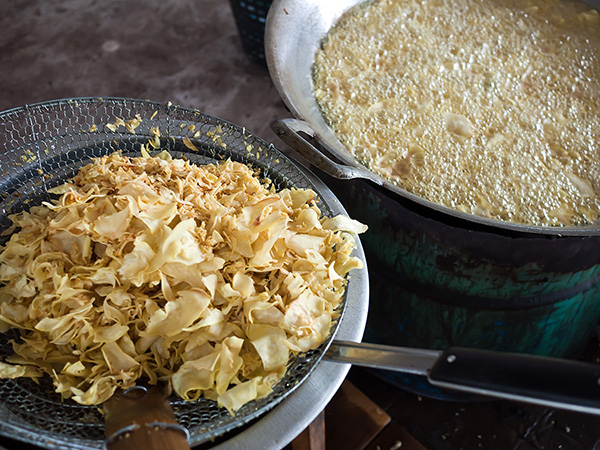There is a substance so noxiously pervasive that car hire agreements, restaurants, hotels, public transport and a multitude of other locations ban it from coming within 1,000 paces.
The substance is durian, an edible fruit with a famously offensive smell. Mmmmmm, sounds delicious.
If that was not enough to put me off, H told me when he first tried it as a youngster in Malaysia, he was instantly and extravagantly sick. Eurk.
And yet, many people can’t get enough of it. And to be fair, I have been known to eat some nasally-challenging foodstuffs.
When I was a kid, every Christmas my dad would purchase himself a gigantic segment of Stilton cheese. I would melodramatically recoil when he urged me to try it, wailing about mould and complaining how much it stunk. I could never, ever foresee a time when I would eat something like that.
My love of cheese in general gradually worked on me, though. I started small, with a little taste and a minimal amount of gagging. Over time I began to enjoy a smidgen of blue cheese on a pizza, and eventually I could smear it all over a piece of bread without a second thought.
Admittedly I prefer milder, creamier varieties such as Saint Agur, but if I’ve learned anything, it’s that something that smells bad can still taste good.
Our Thai host has a friend who owns a fruit orchard, and when May and durian season arrived, a trip was organised so we could see the fruits in-situ and I could have my first taste.
Since H’s early dramatic reaction to durian he had eaten it again and liked it. I was a durian virgin though, and the scents wafting from roadside stalls and markets were not very encouraging.
I find the smell hard to describe. At first I thought “sewer”, but H rightly argued me out of that and towards putrefaction. If you search online (I should point out here that in Thailand it is actually called “thurian”, but I cannot break myself of the Malaysian name usage, and if you want to learn more, durian is the name to search for), you’ll discover an array of other adjectives used, but rotten fruit is the closest we could think of. The smell only kicks in in a big way when the fruit is ripe or has been sitting around for a while, although any enclosed space amplifies it (as we found out driving home with a basketful in the car) and it lingers for days afterwards.
There was no real smell as we bumped our way over the grass to the orchard. After some introductions, a fresh durian was hacked open and I was offered a piece to taste.
As you can see from the photos, durian is a large spiky fruit of the approximate size of a rugby ball, though this does vary. The interior is home to segments of pale yellow flesh dotted with large seeds. I was trying the Mon Thong variety, which I was assured was the best.
The texture was soft and creamy. The nearest parallel I can offer is a bit like a very ripe avocado. It was similarly rich too, with a mild sweet initial taste and a strong aftertaste of corn snacks such as Nik Naks (minus the flavouring).
I didn’t dislike it, but I wasn’t clamouring for more.
We followed it up with a stroll round the orchard, after being warned not to stand or walk beneath any of the fruits dangling from the trees. The image of 5kg of spiky fruit dropping onto my skull certainly made me a little thoughtful, and spying the odd fallen fruit here and there, I switched into “alert tiger” mode, eyes flicking in all directions, twitching at the slightest creak of a branch.
After loading up the car with some prime durian, we then headed over to a nearby market. The Rayong district of Thailand (where we were) was currently celebrating the arrival of many seasonal fruits, and after supplementing our collection with some rambutan, I meandered over to a stall where fresh durian was being sliced and deep-fried to make durian chips.
The canny stall holder offered me a try, and the freshly-cooked chip was sweet and crunchy. I quickly purchased a bag, and although I’m not a big fan of sweeter vegetable crisps such as parsnip and carrot, durian chips were quite a pleasant snack, lacking any offensive smell or unsettling taste.
On returning back home, our Thai host donned some heavy-duty gloves and headed out onto the balcony to disembowel a durian. After tapping the fruits to establish the ripest (I couldn’t discern much difference in the various “tok-tok” sounds but she insisted there was), the skin was hacked off and the flesh was carefully separated and placed in a container in the freezer.
A few hours later we were invited to try icy durian. It was almost a ready-made ice cream. The texture was still soft enough to bite into, and the intensity was subdued by the cold. I found it preferable to raw durian, but it was not the beginning of a love affair.
Durian continued to dominate roadsides until we left Thailand at the end of May. Clearly very popular, I would be fascinated to see it on British supermarket shelves, but it is undeniably a fruit you need to eat at its best, and that is never going to be after air transit, vacuum-packing and whatever other indignities it would need to go through before it would be allowed to sit alongside our more well-behaved Cox’s Orange Pippins or Williams pears.


